理论学习部分:
JAVA的集合框架
l JAVA的集合框架实现对各种数据结构的封装,以降低对数据管理与处理的难度。
l 所谓框架就是一个类库的集合,框架中包含很多超类,编程者创建这些超类的子类可较方便的设计设计程序所需的类。例如:Swing类包
l 集合(Collection或称为容器)是一种包含多个元素并提供对所包含元素操作方法的类,其包含的元素可以由同一类型的对象组成,也可以由不同类型的对象组成。
l 集合框架:JAVA集合类库的统一架构。
1.集合类的作用
l 集合类的作用:
– Java的集合类提供了一些基本数据结构的支持。
– 例如Vector、Hashtable、Stack等。
l 集合类的使用:
– Java的集合类包含在java.util包中。
– import java.util.*;
2.集合类的特点
l 特点一:
– 只容纳对象。
注意:数组可以容纳基本数据类型数据和对象。
– 如果集合类中想使用基本数据类型,又想利用集合类的灵活性,可以把基本数据类型数据封装成该数据类型的包装器对象,然后放入集合中处理。
l 特点二:
– 集合类容纳的对象都是Object类的实例,一旦把一个对象置入集合类中,它的类信息将丢失,这样设计的目的是为了集合类的通用性。
– 因为Object类是所有类的祖先,所以可以在这些集合中存放任何类的对象而不受限制,但切记在使用集合成员之前必须对它重新造型。
3. 新旧集合类
Vector类
Stack类
Hashtable类
Vector类
Vector类类似长度可变的数组。
Vector中只能存放对象。 Vector的元素通过下标进行访问。
Vector类关键属性: – capacity表示集合最多能容纳的元素个数。 – capacityIncrement表示每次增加多少容量。 – size表示集合当前元素个数。
Vector v = new Vector(100)
1、实验目的与要求
(1) 掌握Vetor、Stack、Hashtable三个类的用途及常用API;
(2) 了解java集合框架体系组成;
(3) 掌握ArrayList、LinkList两个类的用途及常用API。
(4) 了解HashSet类、TreeSet类的用途及常用API。
(5)了解HashMap、TreeMap两个类的用途及常用API;
(6) 结对编程(Pair programming)练习,体验程序开发中的两人合作。
2、实验内容和步骤
实验1: 导入第9章示例程序,测试程序并进行代码注释。
测试程序1:
l 使用JDK命令运行编辑、运行以下三个示例程序,结合运行结果理解程序;
掌握Vetor、Stack、Hashtable三个类的用途及常用API。
//示例程序1 import java.util.Vector; class Cat { private int catNumber; Cat(int i) { catNumber = i; } void print() { System.out.println("Cat #" + catNumber); } } class Dog { private int dogNumber; Dog(int i) { dogNumber = i; } void print() { System.out.println("Dog #" + dogNumber); } } public class CatsAndDogs { public static void main(String[] args) { Vector cats = new Vector(); for (int i = 0; i < 7; i++) cats.addElement(new Cat(i)); cats.addElement(new Dog(7)); for (int i = 0; i < cats.size(); i++) ((Cat) cats.elementAt(i)).print(); } }
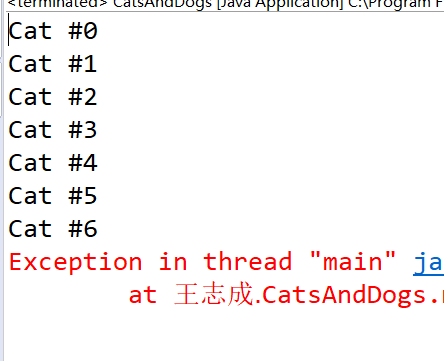
修改为:
package 王志成; import java.util.Vector; class Cat { private int catNumber; Cat(int i) { catNumber = i; } void print() { System.out.println("Cat #" + catNumber); } } class Dog { private int dogNumber; Dog(int i) { dogNumber = i; } void print() { System.out.println("Dog #" + dogNumber); } } public class CatsAndDogs { public static void main(String[] args) { Vector cats = new Vector(); for (int i = 0; i < 7; i++) cats.addElement(new Cat(i)); cats.addElement(new Dog(7)); for(int i = 0;i < cats.size(); i++) { if(cats.elementAt(i) instanceof Cat) { ((Cat) cats.elementAt(i)).print(); }else { ((Dog) cats.elementAt(i)).print(); } } } }
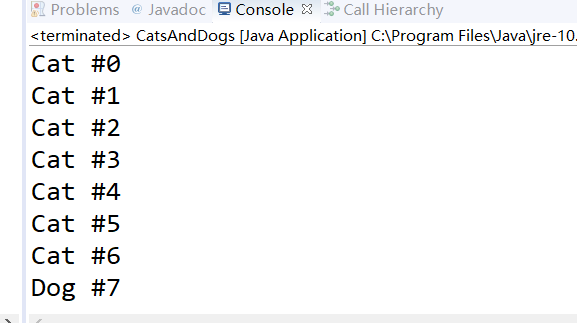
package 王志成; import java.util.*; public class Stacks { static String[] months = { "1", "2", "3", "4" }; public static void main(String[] args) { Stack stk = new Stack(); for (int i = 0; i < months.length; i++) stk.push(months[i]); System.out.println(stk); System.out.println("element 2=" + stk.elementAt(2)); while (!stk.empty()) System.out.println(stk.pop()); } }
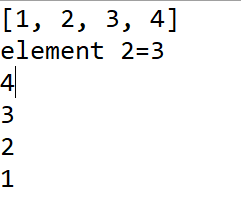
package 王志成; import java.util.*; class Counter { int i = 1; public String toString() { return Integer.toString(i); } } public class Statistics { public static void main(String[] args) { Hashtable ht = new Hashtable(); for (int i = 0; i < 10000; i++) { Integer r = new Integer((int) (Math.random() * 20)); if (ht.containsKey(r)) ((Counter) ht.get(r)).i++; else ht.put(r, new Counter()); } System.out.println(ht); } }

测试程序2:
l 使用JDK命令编辑运行ArrayListDemo和LinkedListDemo两个程序,结合程序运行结果理解程序;
package 王志成; import java.util.*; public class ArrayListDemo { public static void main(String[] argv) { ArrayList<Comparable> al = new ArrayList(); // Add lots of elements to the ArrayList... al.add(new Integer(11)); al.add(new Integer(12)); al.add(new Integer(13)); al.add(new String("hello")); // First print them out using a for loop. System.out.println("Retrieving by index:"); for (int i = 0; i < al.size(); i++) { System.out.println("Element " + i + " = " + al.get(i)); } } }

package 王志成; import java.util.*; public class LinkedListDemo { public static void main(String[] argv) { LinkedList l = new LinkedList(); l.add(new Object()); l.add("Hello"); l.add("zhangsan"); ListIterator li = l.listIterator(0); while (li.hasNext()) System.out.println(li.next()); if (l.indexOf("Hello") < 0) System.err.println("Lookup does not work"); else System.err.println("Lookup works"); } }
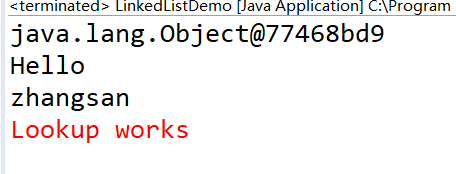
l 在Elipse环境下编辑运行调试教材360页程序9-1,结合程序运行结果理解程序;
l 掌握ArrayList、LinkList两个类的用途及常用API。
package 王志成; import java.util.*; /** * This program demonstrates operations on linked lists. * @version 1.11 2012-01-26 * @author Cay Horstmann */ public class LinkedListTest { public static void main(String[] args) { List<String> a = new LinkedList<>(); a.add("Amy"); a.add("Carl"); a.add("Erica"); List<String> b = new LinkedList<>(); b.add("Bob"); b.add("Doug"); b.add("Frances"); b.add("Gloria"); // merge the words from b into a ListIterator<String> aIter = a.listIterator(); Iterator<String> bIter = b.iterator(); while (bIter.hasNext()) { if (aIter.hasNext()) aIter.next(); aIter.add(bIter.next()); } System.out.println(a); // remove every second word from b bIter = b.iterator(); while (bIter.hasNext()) { bIter.next(); // skip one element if (bIter.hasNext()) { bIter.next(); // skip next element bIter.remove(); // remove that element } } System.out.println(b); // bulk operation: remove all words in b from a a.removeAll(b); System.out.println(a); } }

测试程序3:
l 运行SetDemo程序,结合运行结果理解程序;
package 王志成; import java.util.*; public class SetDemo { public static void main(String[] argv) { HashSet h = new HashSet(); //也可以 Set h=new HashSet() h.add("One"); h.add("Two"); h.add("One"); // DUPLICATE h.add("Three"); Iterator it = h.iterator(); while (it.hasNext()) { System.out.println(it.next()); } } }
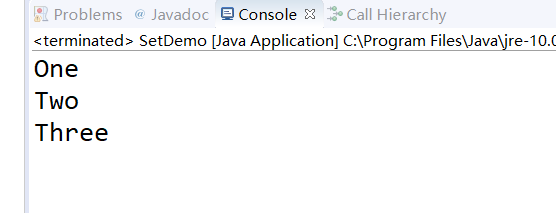
l 在Elipse环境下调试教材365页程序9-2,结合运行结果理解程序;了解HashSet类的用途及常用API。
l 在Elipse环境下调试教材367页-368程序9-3、9-4,结合程序运行结果理解程序;了解TreeSet类的用途及常用API。
package 王志成; import java.util.*; /** * This program uses a set to print all unique words in System.in. * @version 1.12 2015-06-21 * @author Cay Horstmann */ public class SetTest { public static void main(String[] args) { Set<String> words = new HashSet<>(); // HashSet implements Set long totalTime = 0; try (Scanner in = new Scanner(System.in)) { while (in.hasNext()) { String word = in.next(); long callTime = System.currentTimeMillis(); words.add(word); callTime = System.currentTimeMillis() - callTime; totalTime += callTime; } } Iterator<String> iter = words.iterator(); for (int i = 1; i <= 20 && iter.hasNext(); i++) System.out.println(iter.next()); System.out.println(". . ."); System.out.println(words.size() + " distinct words. " + totalTime + " milliseconds."); } }
l 在Elipse环境下调试教材367页-368程序9-3、9-4,结合程序运行结果理解程序;了解TreeSet类的用途及常用API。
package 王志成; import java.util.*; /** * This program sorts a set of item by comparing their descriptions. * @version 1.12 2015-06-21 * @author Cay Horstmann */ public class TreeSetTest { public static void main(String[] args) { SortedSet<Item> parts = new TreeSet<>(); parts.add(new Item("Toaster", 1234)); parts.add(new Item("Widget", 4562)); parts.add(new Item("Modem", 9912)); System.out.println(parts); NavigableSet<Item> sortByDescription = new TreeSet<>( Comparator.comparing(Item::getDescription)); sortByDescription.addAll(parts); System.out.println(sortByDescription); } }
package 王志成; import java.util.*; /** * An item with a description and a part number. */ public class Item implements Comparable<Item>//Item类实现Comparable接口 { private String description; private int partNumber; /** * Constructs an item. * * @param aDescription * the item's description * @param aPartNumber * the item's part number */ public Item(String aDescription, int aPartNumber) { description = aDescription;//字符串 partNumber = aPartNumber; } /** * Gets the description of this item. * * @return the description */ public String getDescription() { return description; } public String toString() { return "[description=" + description + ", partNumber=" + partNumber + "]"; }//返回该对象的字符串表示 public boolean equals(Object otherObject) { if (this == otherObject) return true; if (otherObject == null) return false; if (getClass() != otherObject.getClass()) return false; Item other = (Item) otherObject; return Objects.equals(description, other.description) && partNumber == other.partNumber; } public int hashCode() { return Objects.hash(description, partNumber); } public int compareTo(Item other) { int diff = Integer.compare(partNumber, other.partNumber); return diff != 0 ? diff : description.compareTo(other.description); } }

测试程序4:
使用JDK命令运行HashMapDemo程序,结合程序运行结果理解程序;
package 王志成; import java.util.*; public class HashMapDemo { public static void main(String[] argv) { HashMap h = new HashMap(); // The hash maps from company name to address. h.put("Adobe", "Mountain View, CA"); h.put("IBM", "White Plains, NY"); h.put("Sun", "Mountain View, CA"); String queryString = "Adobe"; String resultString = (String)h.get(queryString); System.out.println("They are located in: " + resultString); } }

l 在Elipse环境下调试教材373页程序9-6,结合程序运行结果理解程序;
l 了解HashMap、TreeMap两个类的用途及常用API。
package 王志成; import java.util.*; /** * This program demonstrates how to extend the collections framework. * @version 1.21 2012-01-26 * @author Cay Horstmann */ public class CircularArrayQueueTest { public static void main(String[] args) { Queue<String> q = new CircularArrayQueue<>(5); q.add("Amy"); q.add("Bob"); q.add("Carl"); q.add("Deedee"); q.add("Emile"); q.remove(); q.add("Fifi"); q.remove(); for (String s : q) System.out.println(s); } } /** A first-in, first-out bounded collection. */ class CircularArrayQueue<E> extends AbstractQueue<E> { private Object[] elements; private int head; private int tail; private int count; private int modcount; /** Constructs an empty queue. @param capacity the maximum capacity of the queue */ public CircularArrayQueue(int capacity) { elements = new Object[capacity]; count = 0; head = 0; tail = 0; } public boolean offer(E newElement) { assert newElement != null; if (count < elements.length) { elements[tail] = newElement; tail = (tail + 1) % elements.length; count++; modcount++; return true; } else return false; } public E poll() { if (count == 0) return null; E r = peek(); head = (head + 1) % elements.length; count--; modcount++; return r; } @SuppressWarnings("unchecked") public E peek() { if (count == 0) return null; return (E) elements[head]; } public int size() { return count; } public Iterator<E> iterator() { return new QueueIterator(); } private class QueueIterator implements Iterator<E> { private int offset; private int modcountAtConstruction; public QueueIterator() { modcountAtConstruction = modcount; } @SuppressWarnings("unchecked") public E next() { if (!hasNext()) throw new NoSuchElementException(); E r = (E) elements[(head + offset) % elements.length]; offset++; return r; } public boolean hasNext() { if (modcount != modcountAtConstruction) throw new ConcurrentModificationException(); return offset < count; } public void remove() { throw new UnsupportedOperationException(); } } }
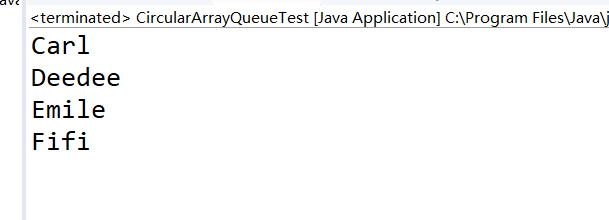
实验2:结对编程练习:
l 关于结对编程:以下图片是一个结对编程场景:两位学习伙伴坐在一起,面对着同一台显示器,使用着同一键盘,同一个鼠标,他们一起思考问题,一起分析问题,一起编写程序。

l 关于结对编程的阐述可参见以下链接:
http://www.cnblogs.com/xinz/archive/2011/08/07/2130332.html
http://en.wikipedia.org/wiki/Pair_programming
l 对于结对编程中代码设计规范的要求参考:
http://www.cnblogs.com/xinz/archive/2011/11/20/2255971.html
以下实验,就让我们来体验一下结对编程的魅力。
l 确定本次实验结对编程合作伙伴;
l 各自运行合作伙伴实验九编程练习1,结合使用体验对所运行程序提出完善建议;
l 各自运行合作伙伴实验十编程练习2,结合使用体验对所运行程序提出完善建议;
合作伙伴:王之泰
合作伙伴的实验代码及结果如下:
实验九:
import java.io.BufferedReader; import java.io.File; import java.io.FileInputStream; import java.io.FileNotFoundException; import java.io.IOException; import java.io.InputStreamReader; import java.util.ArrayList; import java.util.Arrays; import java.util.Collections; import java.util.Scanner; public class main{ private static ArrayList<person> Personlist; public static void main(String[] args) { Personlist = new ArrayList<>(); Scanner scanner = new Scanner(System.in); File file = new File("D:\\身份证号.txt"); try { FileInputStream fis = new FileInputStream(file); BufferedReader in = new BufferedReader(new InputStreamReader(fis)); String temp = null; while ((temp = in.readLine()) != null) { Scanner linescanner = new Scanner(temp); linescanner.useDelimiter(" "); String name = linescanner.next(); String ID = linescanner.next(); String sex = linescanner.next(); String age = linescanner.next(); String place =linescanner.nextLine(); person Person = new person(); Person.setname(name); Person.setID(ID); Person.setsex(sex); int a = Integer.parseInt(age); Person.setage(a); Person.setbirthplace(place); Personlist.add(Person); } } catch (FileNotFoundException e) { System.out.println("查找不到信息"); e.printStackTrace(); } catch (IOException e) { System.out.println("信息读取有误"); e.printStackTrace(); } boolean isTrue = true; while (isTrue) { System.out.println("1:按姓名字典序输出人员信息"); System.out.println("2:查询最大年龄与最小年龄人员信息"); System.out.println("3:输入你的年龄,查询与你最近人的姓名、身份证号、年龄、性别和出生地;"); System.out.println("4:查询是否有同乡"); System.out.println("5:退出"); int nextInt = scanner.nextInt(); switch (nextInt) { case 1: Collections.sort(Personlist); System.out.println(Personlist.toString()); break; case 2: int max=0,min=100;int j,k1 = 0,k2=0; for(int i=1;i<Personlist.size();i++) { j=Personlist.get(i).getage(); if(j>max) { max=j; k1=i; } if(j<min) { min=j; k2=i; } } System.out.println("年龄最大:"+Personlist.get(k1)); System.out.println("年龄最小:"+Personlist.get(k2)); break; case 3: System.out.println("年龄:"); int yourage = scanner.nextInt(); int near=agenear(yourage); int d=yourage-Personlist.get(near).getage(); System.out.println(""+Personlist.get(near)); break; case 4: System.out.println("你的家乡?"); String find = scanner.next(); String place=find.substring(0,3); String place2=find.substring(0,3); for (int i = 0; i <Personlist.size(); i++) { if(Personlist.get(i).getbirthplace().substring(1,4).equals(place)) System.out.println(""+Personlist.get(i)); } break; case 5: isTrue = false; System.out.println("退出程序!"); break; default: System.out.println("输入有误"); } } } public static int agenear(int age) { int j=0,min=53,d=0,k=0; for (int i = 0; i < Personlist.size(); i++) { d=Personlist.get(i).getage()-age; if(d<0) d=-d; if (d<min) { min=d; k=i; } } return k; } }
public class person implements Comparable<person> { private String name; private String ID; private int age; private String sex; private String birthplace; public String getname() { return name; } public void setname(String name) { this.name = name; } public String getID() { return ID; } public void setID(String ID) { this.ID= ID; } public int getage() { return age; } public void setage(int age) { // int a = Integer.parseInt(age); this.age= age; } public String getsex() { return sex; } public void setsex(String sex) { this.sex= sex; } public String getbirthplace() { return birthplace; } public void setbirthplace(String birthplace) { this.birthplace= birthplace; } public int compareTo(person o) { return this.name.compareTo(o.getname()); } public String toString() { return name+"\t"+sex+"\t"+age+"\t"+ID+"\t"+birthplace+"\n"; } }
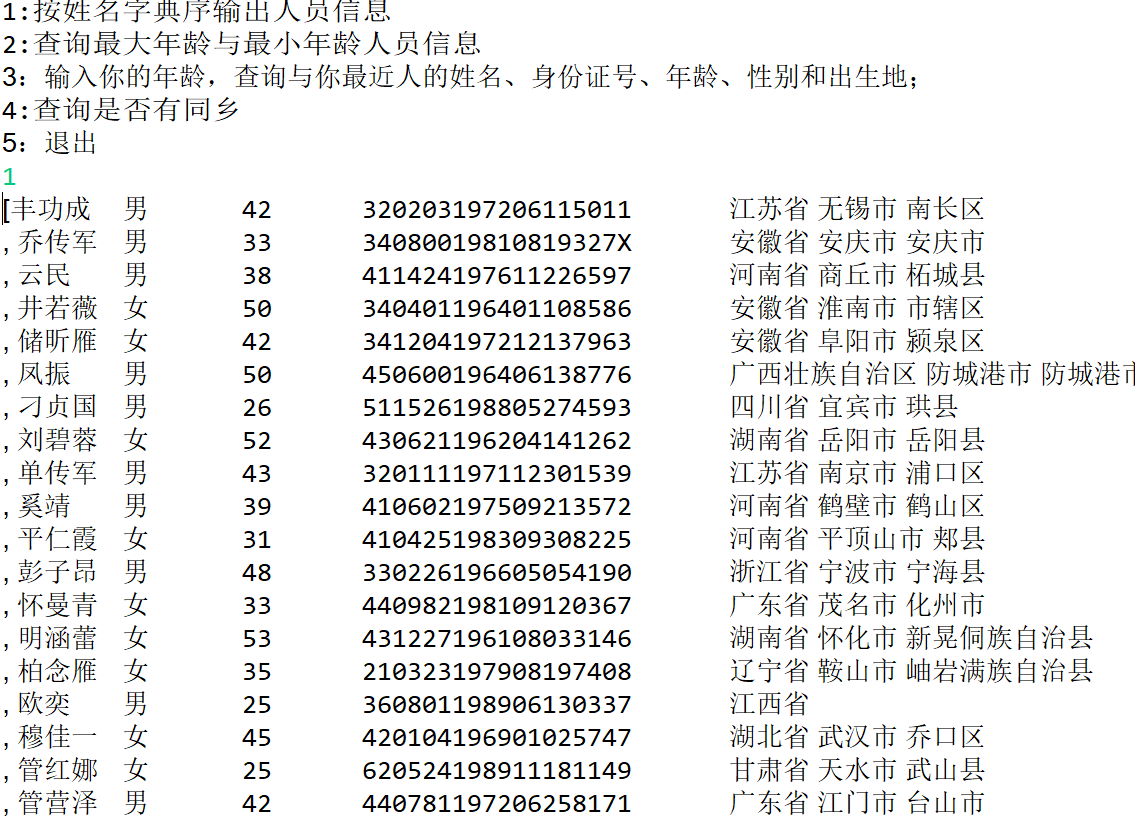


实验十
import java.io.File;
import java.io.FileOutputStream;
import java.io.PrintWriter;
import java.math.BigDecimal;
import java.util.Scanner;
public class ss {
public static void main(String[] args) {
Scanner in = new Scanner(System.in);
Calculator<Integer> sf = new Calculator<Integer>();
File file = new File("wzt.txt");
if(file.exists()) {
System.out.println("文件已存在");
}
PrintWriter output = null;
try {
output = new PrintWriter(new FileOutputStream(file));
} catch (Exception e) {
//e.printStackTrace();
}
int sum = 0;
System.out.println("计算结果保留两位小数");
for (int i = 1; i < 11; i++) {
int a = (int) Math.round(Math.random() * 100);
int b = (int) Math.round(Math.random() * 100);
int s = (int) Math.round(Math.random() * 3);
switch(s)
{
case 1:
System.out.println(i+": "+a+"/"+b+"=");
Number c = in.nextDouble();
output.println(a+"/"+b+"="+c);
Number g = sf.division(a, b);
BigDecimal division = new BigDecimal(g.doubleValue());
g = division.setScale(2, BigDecimal.ROUND_HALF_UP).doubleValue();
if (c.equals(g)) {
sum += 10;
System.out.println("恭喜答案正确");
}
else {
System.out.println("抱歉,答案错误");
}
break;
case 2:
System.out.println(i+": "+a+"*"+b+"=");
Number c1 = in.nextDouble();
output.println(a+"*"+b+"="+c1);
Number g1 = sf.mulitiplication(a, b);
BigDecimal mul = new BigDecimal(g1.doubleValue());
g1 = mul.setScale(2, BigDecimal.ROUND_HALF_UP).doubleValue();
if (c1.equals(g1) ){
sum += 10;
System.out.println("恭喜答案正确");
}
else {
System.out.println("抱歉,答案错误");
}
break;
case 3:
System.out.println(i+": "+a+"+"+b+"=");
Number c2 = in.nextDouble();
output.println(a+"+"+b+"="+c2);
Number g2 =sf.addition(a, b);
BigDecimal add = new BigDecimal(g2.doubleValue());
g2 = add.setScale(2, BigDecimal.ROUND_HALF_UP).doubleValue();
if (c2.equals(g2)) {
sum += 10;
System.out.println("恭喜答案正确");
}
else {
System.out.println("抱歉,答案错误");
}
break ;
case 4:
System.out.println(i+": "+a+"-"+b+"=");
Number c3 = in.nextDouble();
output.println(a+"-"+b+"="+c3);
Number g3 = sf.subtraction(a, b);
BigDecimal sub = new BigDecimal(g3.doubleValue());
g3 = sub.setScale(2, BigDecimal.ROUND_HALF_UP).doubleValue();
if (c3.equals(g3)) {
sum += 10;
System.out.println("恭喜答案正确");
}
else {
System.out.println("抱歉,答案错误");
}
break ;
}
}
System.out.println("成绩"+sum);
output.println("成绩:"+sum);
output.close();
in.close();
}
}
public class Calculator<T> { public Calculator() { // TODO Auto-generated constructor stub } public Number addition(T m,T n) { return Double.parseDouble(m.toString())+Double.parseDouble(n.toString()); } public Number subtraction(T m,T n) { return Double.parseDouble(m.toString())-Double.parseDouble(n.toString()); } public Number mulitiplication(T m,T n) { return Double.parseDouble(m.toString())*Double.parseDouble(n.toString()); } public Number division(T m,T n) { if(Double.parseDouble(n.toString()) != 0) return Double.parseDouble(m.toString())/Double.parseDouble(n.toString()); else return 0; } }
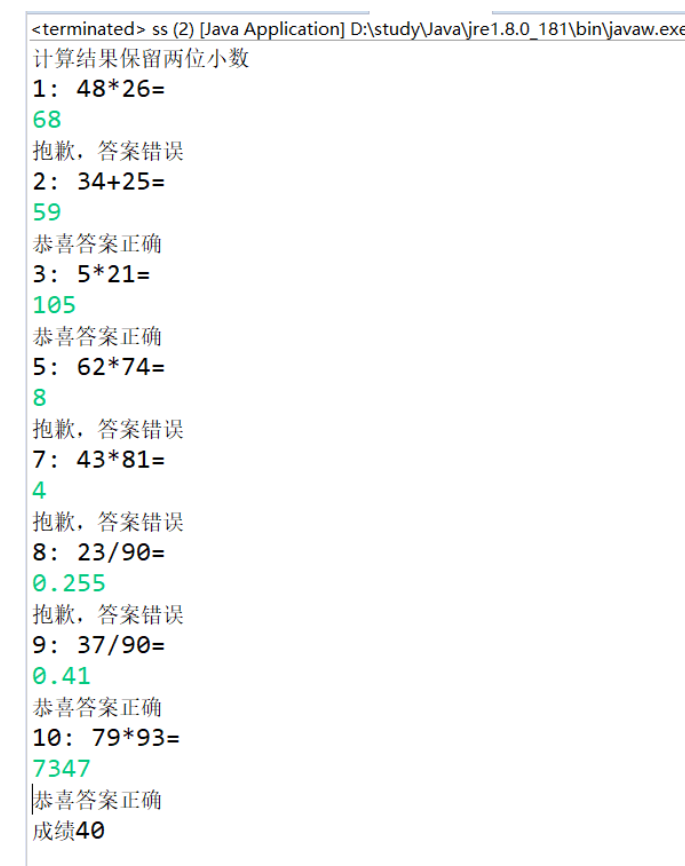
完善意见:通过运行他的实验代码,可以看出他的代码写得很完善,很严谨,但或许会有一丝繁琐,可以适当的简化,但对现阶段的我们来说,这样或许更好的能帮助我们加深所学知识的理解。
结对编程代码如下:
package jiedui_bianchen; import java.io.BufferedReader; import java.io.File; import java.io.FileInputStream; import java.io.FileNotFoundException; import java.io.IOException; import java.io.InputStreamReader; import java.util.ArrayList; import java.util.Scanner; import java.util.Collections; public class ID { public static People findPeopleByname(String name) { People flag = null; for (People people : peoplelist) { if(people.getName().equals(name)) { flag = people; } } return flag; } public static People findPeopleByid(String id) { People flag = null; for (People people : peoplelist) { if(people.getnumber().equals(id)) { flag = people; } } return flag; } private static ArrayList<People> agenear(int yourage) { // TODO Auto-generated method stub int j=0,min=53,d_value=0,k = 0; ArrayList<People> plist = new ArrayList<People>(); for (int i = 0; i < peoplelist.size(); i++) { d_value = peoplelist.get(i).getage() > yourage ? peoplelist.get(i).getage() - yourage : yourage - peoplelist.get(i).getage() ; k = d_value < min ? i : k; min = d_value < min ? d_value : min; } for(People people : peoplelist) { if(people.getage() == peoplelist.get(k).getage()) { plist.add(people); } } return plist; } private static ArrayList<People> peoplelist; public static void main(String[] args) //throws IOException { peoplelist = new ArrayList<People>(); Scanner scanner = new Scanner(System.in); File file = new File("D:\\身份证号.txt"); try { FileInputStream files = new FileInputStream(file); BufferedReader in = new BufferedReader(new InputStreamReader(files)); String temp = null; while ((temp = in.readLine()) != null) { String[] information = temp.split("[ ]+"); People people = new People(); people.setName(information[0]); people.setnumber(information[1]); int A = Integer.parseInt(information[3]); people.setage(A); people.setsex(information[2]); for(int j = 4; j<information.length;j++) { people.setplace(information[j]); } peoplelist.add(people); } } catch (FileNotFoundException e) { System.out.println("文件未找到"); e.printStackTrace(); } catch (IOException e) { System.out.println("文件读取错误"); e.printStackTrace(); } boolean isTrue = true; while (isTrue) { System.out.println("******************************************"); System.out.println(" 1.按姓名典序输出人员信息"); System.out.println(" 2.查询最大年龄人员信息"); System.out.println(" 3.查询最小年龄人员信息"); System.out.println(" 4.输入你的年龄,查询身份证号.txt中年龄与你最近的人"); System.out.println(" 5.查询人员中是否有你的同乡"); System.out.println(" 6.退出"); System.out.println("******************************************"); int nextInt = scanner.nextInt(); switch (nextInt) { case 1: Collections.sort(peoplelist); System.out.println(peoplelist.toString()); break; case 2: int max=0; int j,k1 = 0; for(int i=1;i<peoplelist.size();i++) { j = peoplelist.get(i).getage(); if(j>max) { max = j; k1 = i; } } System.out.println("年龄最大:"+peoplelist.get(k1)); break; case 3: int min = 100; int j1,k2 = 0; for(int i=1;i<peoplelist.size();i++) { j1 = peoplelist.get(i).getage(); if(j1<min) { min = j1; k2 = i; } } System.out.println("年龄最小:"+peoplelist.get(k2)); break; case 4: System.out.println("年龄:"); int input_age = scanner.nextInt(); ArrayList<People> plist = new ArrayList<People>(); plist = agenear(input_age); for(People people : plist) { System.out.println(people.toString()); } break; case 5: System.out.println("请输入省份"); String find = scanner.next(); for (int i = 0; i <peoplelist.size(); i++) { String [] place = peoplelist.get(i).getplace().split("\t"); for(String temp : place) { if(find.equals(temp)) { System.out.println("你的同乡是 "+peoplelist.get(i)); break; } } } break; case 6: isTrue = false; System.out.println("byebye!"); break; default: System.out.println("输入有误"); } } } }
结对程序运行功能界面截图;

结对过程描述,提供两人在讨论、细化和编程时的结对照片(非摆拍)。

5.采用结对编程方式,与学习伙伴合作完成实验十编程练习2。
import java.io.File; import java.io.FileOutputStream; import java.io.PrintWriter; import java.math.BigDecimal; import java.util.Scanner; public class ss { public static void main(String[] args) { Scanner in = new Scanner(System.in); Calculator<Integer> sf = new Calculator<Integer>(); File file = new File("wzt.txt"); if(file.exists()) { System.out.println("文件已存在"); } PrintWriter output = null; try { output = new PrintWriter(new FileOutputStream(file)); } catch (Exception e) { //e.printStackTrace(); } int sum = 0; System.out.println("计算结果保留两位小数"); for (int i = 1; i < 11; i++) { int a = (int) Math.round(Math.random() * 100); int b = (int) Math.round(Math.random() * 100); int s = (int) Math.round(Math.random() * 3); switch(s) { case 1: System.out.println(i+": "+a+"/"+b+"="); Number c = in.nextDouble(); output.println(a+"/"+b+"="+c); Number g = sf.division(a, b); BigDecimal division = new BigDecimal(g.doubleValue()); g = division.setScale(2, BigDecimal.ROUND_HALF_UP).doubleValue(); if (c.equals(g)) { sum += 10; System.out.println("恭喜答案正确"); } else { System.out.println("抱歉,答案错误"); } break; case 2: System.out.println(i+": "+a+"*"+b+"="); Number c1 = in.nextDouble(); output.println(a+"*"+b+"="+c1); Number g1 = sf.mulitiplication(a, b); BigDecimal mul = new BigDecimal(g1.doubleValue()); g1 = mul.setScale(2, BigDecimal.ROUND_HALF_UP).doubleValue(); if (c1.equals(g1) ){ sum += 10; System.out.println("恭喜答案正确"); } else { System.out.println("抱歉,答案错误"); } break; case 3: System.out.println(i+": "+a+"+"+b+"="); Number c2 = in.nextDouble(); output.println(a+"+"+b+"="+c2); Number g2 =sf.addition(a, b); BigDecimal add = new BigDecimal(g2.doubleValue()); g2 = add.setScale(2, BigDecimal.ROUND_HALF_UP).doubleValue(); if (c2.equals(g2)) { sum += 10; System.out.println("恭喜答案正确"); } else { System.out.println("抱歉,答案错误"); } break ; case 4: System.out.println(i+": "+a+"-"+b+"="); Number c3 = in.nextDouble(); output.println(a+"-"+b+"="+c3); Number g3 = sf.subtraction(a, b); BigDecimal sub = new BigDecimal(g3.doubleValue()); g3 = sub.setScale(2, BigDecimal.ROUND_HALF_UP).doubleValue(); if (c3.equals(g3)) { sum += 10; System.out.println("恭喜答案正确"); } else { System.out.println("抱歉,答案错误"); } break ; } } System.out.println("成绩"+sum); output.println("成绩:"+sum); output.close(); in.close(); } }
结对程序运行功能界面截图;
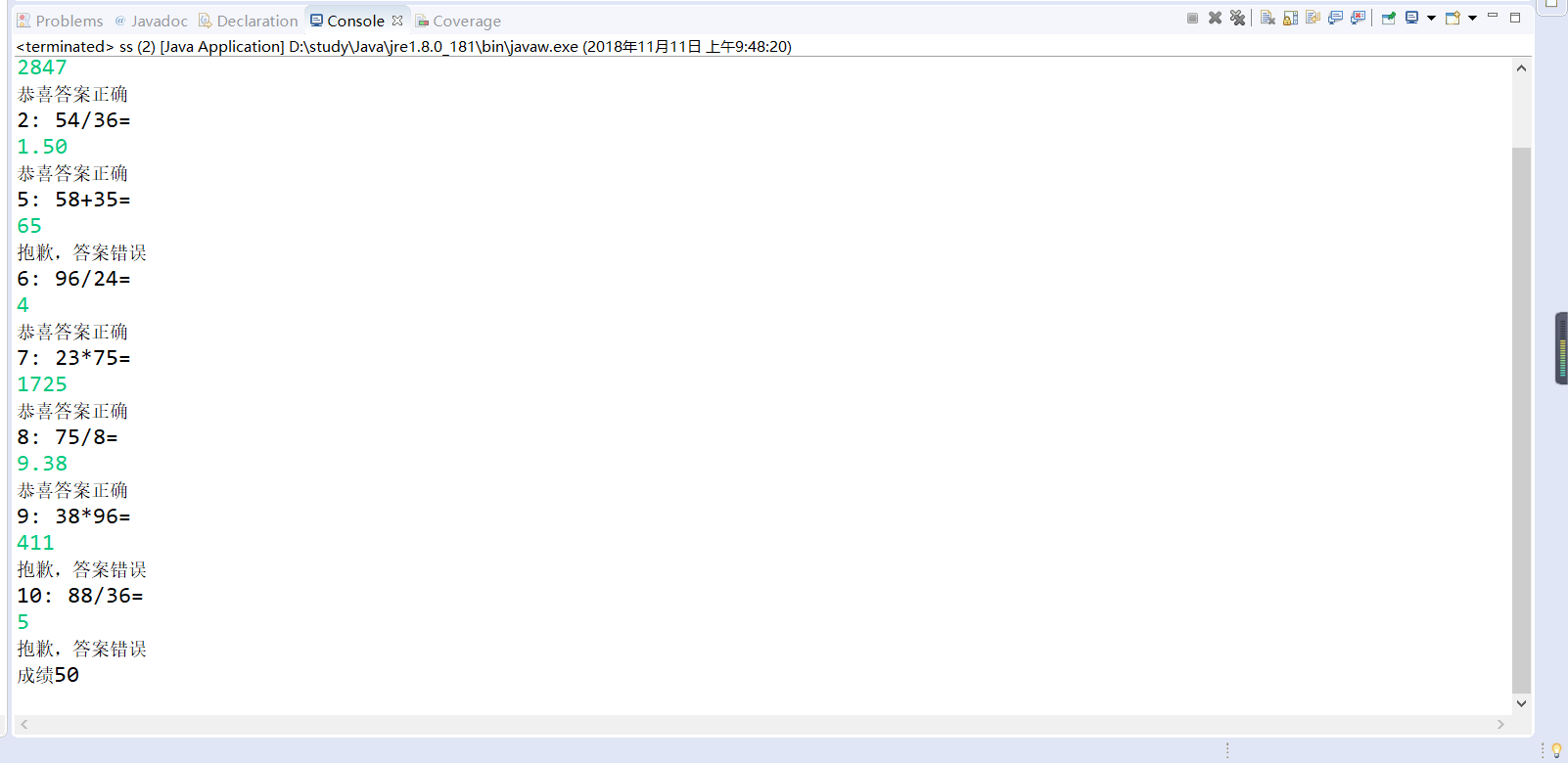
结对过程描述,提供两人在讨论、细化和编程时的结对照片(非摆拍)。

总结 :通过这周的Java课程的学习,基本掌握了java中集合的概念,学习了集合的知识以及使用方法。实验中,运用了结对编程的方法, 通过结对编程,极大的提高了我们的编程兴趣,和编程效率,是一种很好的编程方式。


